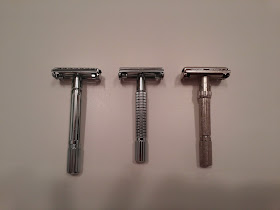 |
| Shave oil at left, and shave butter in the original tin jar and the new packaging, the squeeze tube, in which the shave butter will be sold going forward. |
Developed and manufactured at the direction of a professional barber, these products are a wet-shaving alternative to traditional shaving soaps and creams, most of which are formulas that have evolved from common bath and body soap. The Old Woodward Shave Co. products are significantly different. Their primary shaving cream, called Shave Butter, is intended to replace traditional shaving lather. It is applied directly out of the tube or jar with fingers, not brush, to a properly warmed and wetted beard. Their related product, their shave oil, can be applied just prior to the shave butter for an additional protective and easy-gliding preparatory step, or can be used alone for those with light beards. These are high-end, luxury products at moderate price points.
The shave oil is light in both color and viscosity, and is based, in part, on a relatively new (to me, anyway -- even as a registered dietitian-nutritionist!) omega-3 oil, Camelina Oil, which is also high in vitamin E.
 Over this, one can rub on a thin layer of their Shave Butter, which is the consistency of a thin pudding. The product is creamy white, and can be applied thinner than pictured, at right, in my dry palm. When applied on a wet face, even when spread quite thin, the Shave Butter offers excellent glide and lubrication.
Over this, one can rub on a thin layer of their Shave Butter, which is the consistency of a thin pudding. The product is creamy white, and can be applied thinner than pictured, at right, in my dry palm. When applied on a wet face, even when spread quite thin, the Shave Butter offers excellent glide and lubrication.The Shave Butter feels cool against the warm, wetted beard, and the version I tested had a slight minty scent that compliments the natural feel of the product. (It is also available in clove scent.)
The shave is where the oil-&-shave-butter combination really excels. Due to the lubrication and glide that this shave-prep combination offers, it inspires extreme confidence; I had to remind myself more than once to slow my shaving strokes just in case in my cockiness I did something inappropriate.
I got a smooth, comfortable three-pass shave with adequate moisturization even in my trouble areas under the corners of my mouth and on my lower neck. Once the product is rinsed off with the usual warm then cool water, there is the same slight residual oil layer that I have when I use my normal shave oil and shaving lather. I choose to leave this as a face protectant. (And I actually then apply an after-shave gel supplemented with a few drops of Jojoba or vitamin E oil.) If I had more oily skin, I might do a quick soap-and-water wash, or just apply Witch Hazel or other after-shave lotion.
The Old Woodward Shave Co.'s Shave Butter is also available in travel sizes. Travel is another area where these products might be particularly handy because you have no need to pack a shave brush.
The barber who developed these products is also the proprietor of The Barber Pole, a barber shop in downtown Birmingham, Michigan on Old Woodward Avenue. In addition to finding Old Woodward Shave Co. products at The Barber Pole, they can also be purchased at the following shops in Michigan:
- Detroit Athletic Club
- Plum Markets
- Lark & Co. (Birmingham, MI)
- Heart of Michigan (Howell, MI)
- Village Saltbox (Metamora, MI)
For more information on products, ordering on line, product pricing, telephone number, a walk-in address, and a video showing a professional straight-razor shave, check out www.oldwoodwardshaveco.com.
In the spirit of full disclosure, I received the pictured products as free samples from The Old Woodward Shave Co.
Happy shaving!
Happy shaving!
















